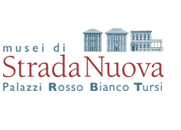The first exhibition in the Palazzo Bianco dates back to 1889 and was curated by painter Giuseppe Isola (1808-1893), already artistic counsellor of the Dukes of Galliera.
1892 was the year of the legacy by Senator Giovanni Ricci and of the Exhibition of Ancient Art, organised on the occasion of the 400th anniversary of Columbus’s discovery of the New World. The museum was reopened to the public in 1893 with an exhibition of sculptures, antique and modern paintings, archaeological pieces, tombstones and furniture, with no particular ordering criteria, in accordance with the taste of the time. Moreover, in those years and up until 1914, the Palazzo was still partially occupied by private tenants.
Thanks largely to the work of Gaetano Poggi, first Councillor of Fine Arts, between 1906 and 1915 the collections were exhibited according to historical and thematic criteria, thus creating distinct museums: the Museum of History and Art, of Risorgimento, and of the War.
In the 1920s, thanks to the efforts of Orlando Grosso (1882-1968), director of the Fine Arts office and of the Galleries, the civic museums became a veritable “system” with specialised and decentralised institutes across the city.
Between 1928 and 1932, the Palazzo Bianco was re-arranged according to the time period and school, under the guidelines of contemporary museology. New rich additions were also included, such as the picture gallery from Casa Piola, bequeathed by Carlotta Ageno De Simoni in 1913, and Enrico L. Peirano’s legacy of 1926.
The paintings were exhibited on the main floor (alongside furniture and tapestries), arranged by period and school, spaced out, rarely overlapping and preferably aligned to bottom. The works of early painters were arranged on the ground floor, next to sculptures and ceramics.
Largely destroyed in 1942 by the WWII bombings, the Palazzo Bianco in a picture of 1928: the hall on the ground floor with the monument of Margherita di Brabante. The Palazzo was rebuilt with its 18th-century appearance and, at its reopening in 1950, the exhibition was rearranged, as decided by Caterina Marcenaro (1906-1976), the new director of the Office of Fine Arts, with a layout designed by rationalist architect Franco Albini (1905-1977).
Based on a rigorous selection of works on display and unprecedented museological choices, the result was high profile, contrasting the more traditional expectations and drawing the attention of the cultural world at the national and international level.
The exhibition was characterised by an extreme formal rigour, as denoted by the light grey colour of the walls and vaults, the uniform flooring, the clever use of lighting, as well as by the display stands made with poor, industrial materials painted black.
It also stood out for the panelling in a rough cut slate of some rooms, for the revolutionary organisation and unrestricted mobility in the arrangement of the works.
In the 1970, the sculptures and the frescoes of the exhibition were transferred to the newly established Museum of St. Agostino, thus giving the Palazzo Bianco its present appearance of a painting gallery.
When Genoa was named the European Capital of Culture for 2004, the Palazzo Bianco became part of a unified museum complex, together with the Palazzo Rosso and Palazzo Tursi, devoted to ancient art. The union of the three buildings in an uninterrupted exhibition, with each museum still retaining its specific historic features and collections, has thus transformed the 16th-century Strada Nuova into a veritable “museum-street”, a masterpiece of the Genoese architectural and residential tradition, and home to a one-of-a-kind cultural institution for its size, features, quality and prestige: the Museums of Strada Nuova.
The arrangement of the works contained in the Palazzo Bianco was fully completed in 2008, so as to allow a more rational path inside the museum. The evolution of figurative culture in Genoa between the 16th and 18th centuries is now presented chronologically, not only through the works of the best-known local masters but also of Italian and international artists who have worked for Genoese patrons or whose paintings were part of the renowned collections of the great families of the city. The Palazzo Bianco also stands out for its significant collection of Flemish paintings and for a monographic room dedicated to 16th-century Spanish painting. The exhibition of the painting gallery continues in some of the rooms of the Palazzo Doria Tursi, ending with a suggestive area devoted to one of the most significant works by Canova, the Repentant Magdalene (1790), purchased by the Dukes of Galliera in Paris.




